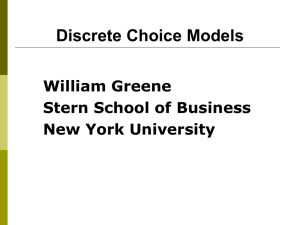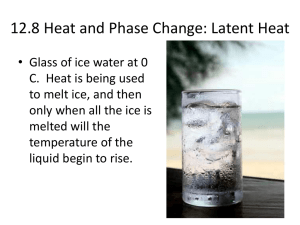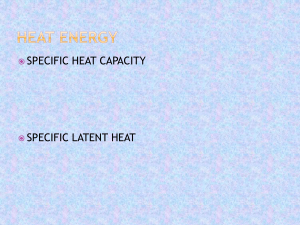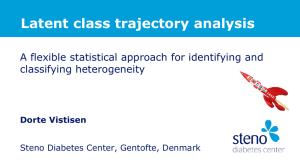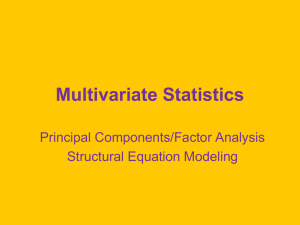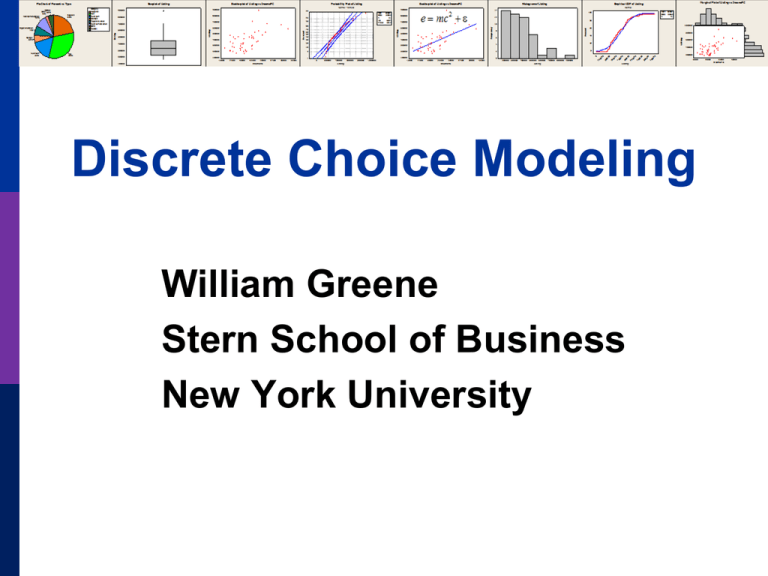
Discrete Choice Modeling
William Greene
Stern School of Business
New York University
Part 7-1
Latent Class Models
Discrete Parameter Heterogeneity
Latent Classes
D iscre te u n o b se rv a b le p a rtitio n o f th e p o p u la tio n
in to Q cla sse s
D iscre te a p p ro xim a tio n to a c o n tin u o u s d istrib u tio n
o f p a ra m e te rs a cro ss in d iv id u a ls
P ro b [β = β q | w i ] = π iq , q = 1 ,..., Q
π iq =
e xp ( q w i )
Q
q=1
e xp ( q w i )
Latent Class Probabilities
Ambiguous – Classical Bayesian model?
Equivalent to random parameters models with
discrete parameter variation
The randomness of the class assignment is from the point of view
of the observer, not a natural process governed by a discrete
distribution.
Using nested logits, etc. does not change this
Precisely analogous to continuous ‘random parameter’ models
Not always equivalent – zero inflation models – in
which classes have completely different models
A Latent Class MNL Model
Within a “class”
P [ch o ice j | i, t, cla ss = q ] =
e xp (α j + β q x itj + γ j,q z it )
J(i)
j=1
e xp (α j + β q x itj + γ j,q z it )
Class sorting is probabilistic (to the analyst) determined
by individual characteristics
P [cla ss q | i] =
e xp ( θ q w i )
Q
c =1
e xp ( θ c w i )
= H iq
Two Interpretations of Latent Classes
H e te ro g e n e ity w ith re s p e c t to 'la te n t' c o n s u m e r c la s s e s
P r(C h o ice i ) =
Q
q=1
P r(C h o ice i | cla ss = q )P r(C la ss = q )
P r(C h o ice i | C la ss = q ) =
P r(C la ss = q | i) = Fi,q =
e xp ( β q x i,c h o ic e )
Σ j= c h o ic e e xp ( β q x i,c h o ic e )
e xp ( θ q z i )
Σ q= c la s s e s e xp ( θ q z i )
D is c re te ra n d o m p a ra m e te r va ria tio n
e xp ( β i x i, j )
P r(C h o ice i | β i ) =
Σ j= c h o ic e e xp ( β i x i, j )
P r( β i = β q ) = Fi,q =
P r(C h o ice i ) =
e xp ( θ q z i )
Σ q= c la s s e s e xp ( θ q z i )
Q
q=1
, q = 1 ,..., Q
P r(ch o ice | β i = β q )P r( β i = β q )
Estimates from the LCM
Taste parameters within each class q
Parameters of the class probability model, θq
For each person:
Posterior estimates of the class they are in q|i
Posterior estimates of their taste parameters E[q|i]
Posterior estimates of their behavioral parameters,
elasticities, marginal effects, etc.
Using the Latent Class Model
Computing posterior (individual specific) class probabilities
Fˆ q|i =
Pˆ i|qFˆ iq
Q
q=1
Pˆ i|qHˆ iq
(p o ste rio r)
N o te Fˆ q|i vs. Fˆ iq
Fˆ iq = e stim a te d p rio r cla ss p ro b a b ility
Pˆ i|q = e stim a te d ch o ice p ro b a b ility fo r
th e ch o ice m a d e , g iv e n th e cla ss
Computing posterior (individual specific) taste parameters
βˆ i =
ˆ βˆ
F
q=1 q|i q
Q
Application: Shoe Brand Choice
Simulated Data: Stated Choice, 400 respondents, 8
choice situations, 3,200 observations
3 choice/attributes + NONE
Fashion = High / Low
Quality = High / Low
Price = 25/50/75,100 coded 1,2,3,4
Heterogeneity: Sex, Age (<25, 25-39, 40+)
Underlying data generated by a 3 class latent class
process (100, 200, 100 in classes)
Thanks to www.statisticalinnovations.com (Latent Gold)
One Class MNL Estimates
----------------------------------------------------------Discrete choice (multinomial logit) model
Dependent variable
Choice
Log likelihood function
-4158.50286
Estimation based on N =
3200, K =
4
R2=1-LogL/LogL* Log-L fncn R-sqrd R2Adj
Constants only -4391.1804 .0530 .0510
Response data are given as ind. choices
Number of obs.= 3200, skipped
0 obs
--------+-------------------------------------------------Variable| Coefficient
Standard Error b/St.Er. P[|Z|>z]
--------+-------------------------------------------------FASH|1|
1.47890***
.06777
21.823
.0000
QUAL|1|
1.01373***
.06445
15.730
.0000
PRICE|1|
-11.8023***
.80406
-14.678
.0000
ASC4|1|
.03679
.07176
.513
.6082
--------+--------------------------------------------------
Application: Brand Choice
True underlying model is a three class LCM
NLOGIT
; Lhs=choice
; Choices=Brand1,Brand2,Brand3,None
; Rhs = Fash,Qual,Price,ASC4
; LCM=Male,Age25,Age39
; Pts=3
; Pds=8
; Par (Save posterior results) $
Three Class LCM
Normal exit from iterations. Exit status=0.
----------------------------------------------------------Latent Class Logit Model
Dependent variable
CHOICE
Log likelihood function
-3649.13245 LogL for one class MNL = -4158.503
Restricted log likelihood
-4436.14196
Chi squared [ 20 d.f.]
1574.01902 Based on the LR statistic it would
Significance level
.00000 seem unambiguous to reject the one
McFadden Pseudo R-squared
.1774085
class model. The degrees of freedom
Estimation based on N =
3200, K = 20
R2=1-LogL/LogL* Log-L fncn R-sqrd R2Adj for the test are uncertain, however.
No coefficients -4436.1420 .1774 .1757
Constants only -4391.1804 .1690 .1673
At start values -4158.5428 .1225 .1207
Response data are given as ind. choices
Number of latent classes =
3
Average Class Probabilities
.506 .239 .256
LCM model with panel has
400 groups
Fixed number of obsrvs./group=
8
Number of obs.= 3200, skipped
0 obs
--------+--------------------------------------------------
Estimated LCM: Utilities
--------+-------------------------------------------------Variable| Coefficient
Standard Error b/St.Er. P[|Z|>z]
--------+-------------------------------------------------|Utility parameters in latent class -->> 1
FASH|1|
3.02570***
.14549
20.796
.0000
QUAL|1|
-.08782
.12305
-.714
.4754
PRICE|1|
-9.69638***
1.41267
-6.864
.0000
ASC4|1|
1.28999***
.14632
8.816
.0000
|Utility parameters in latent class -->> 2
FASH|2|
1.19722***
.16169
7.404
.0000
QUAL|2|
1.11575***
.16356
6.821
.0000
PRICE|2|
-13.9345***
1.93541
-7.200
.0000
ASC4|2|
-.43138**
.18514
-2.330
.0198
|Utility parameters in latent class -->> 3
FASH|3|
-.17168
.16725
-1.026
.3047
QUAL|3|
2.71881***
.17907
15.183
.0000
PRICE|3|
-8.96483***
1.93400
-4.635
.0000
ASC4|3|
.18639
.18412
1.012
.3114
Estimated LCM: Class Probability Model
--------+-------------------------------------------------Variable| Coefficient
Standard Error b/St.Er. P[|Z|>z]
--------+-------------------------------------------------|This is THETA(01) in class probability model.
Constant|
-.90345**
.37612
-2.402
.0163
_MALE|1|
.64183*
.36245
1.771
.0766
_AGE25|1|
2.13321***
.32096
6.646
.0000
_AGE39|1|
.72630*
.43511
1.669
.0951
|This is THETA(02) in class probability model.
Constant|
.37636
.34812
1.081
.2796
_MALE|2|
-2.76536***
.69325
-3.989
.0001
_AGE25|2|
-.11946
.54936
-.217
.8279
_AGE39|2|
1.97657***
.71684
2.757
.0058
|This is THETA(03) in class probability model.
Constant|
.000
......(Fixed Parameter)......
_MALE|3|
.000
......(Fixed Parameter)......
_AGE25|3|
.000
......(Fixed Parameter)......
_AGE39|3|
.000
......(Fixed Parameter)......
--------+--------------------------------------------------
Estimated LCM:
Conditional Parameter Estimates
Estimated LCM: Conditional (Posterior)
Class Probabilities
Average Estimated Class Probabilities
MATRIX ; list ; 1/400 * classp_i'1$
Matrix Result has 3 rows and 1 columns.
1
+-------------1|
.50555
2|
.23853
3|
.25593
This is how the data were simulated. Class
probabilities are .5, .25, .25. The model ‘worked.’
Elasticities
+---------------------------------------------------+
| Elasticity
averaged over observations.|
| Effects on probabilities of all choices in model: |
| * = Direct Elasticity effect of the attribute.
|
| Attribute is PRICE
in choice BRAND1
|
|
Mean
St.Dev
|
| *
Choice=BRAND1
-.8010
.3381
|
|
Choice=BRAND2
.2732
.2994
|
|
Choice=BRAND3
.2484
.2641
|
|
Choice=NONE
.2193
.2317
|
+---------------------------------------------------+
| Attribute is PRICE
in choice BRAND2
|
|
Choice=BRAND1
.3106
.2123
|
| *
Choice=BRAND2
-1.1481
.4885
|
|
Choice=BRAND3
.2836
.2034
|
|
Choice=NONE
.2682
.1848
|
+---------------------------------------------------+
| Attribute is PRICE
in choice BRAND3
|
|
Choice=BRAND1
.3145
.2217
|
|
Choice=BRAND2
.3436
.2991
|
| *
Choice=BRAND3
-.6744
.3676
|
|
Choice=NONE
.3019
.2187
|
+---------------------------------------------------+
Elasticities are computed by
averaging individual elasticities
computed at the expected
(posterior) parameter vector.
This is an unlabeled choice
experiment. It is not possible to
attach any significance to the fact
that the elasticity is different for
Brand1 and Brand 2 or Brand 3.
Application: Long Distance Drivers’
Preference for Road Environments
New Zealand survey, 2000, 274 drivers
Mixed revealed and stated choice experiment
4 Alternatives in choice set
The current road the respondent is/has been using;
A hypothetical 2-lane road;
A hypothetical 4-lane road with no median;
A hypothetical 4-lane road with a wide grass median.
16 stated choice situations for each with 2 choice profiles
choices involving all 4 choices
choices involving only the last 3 (hypothetical)
Hensher and Greene, A Latent Class Model for Discrete Choice Analysis:
Contrasts with Mixed Logit – Transportation Research B, 2003
Attributes
Time on the open road which is free flow (in
minutes);
Time on the open road which is slowed by other
traffic (in minutes);
Percentage of total time on open road spent with
other vehicles close behind (ie tailgating) (%);
Curviness of the road (A four-level attribute almost straight, slight, moderate, winding);
Running costs (in dollars);
Toll cost (in dollars).
Experimental Design
The four levels of the six attributes chosen are:
Free Flow Travel Time:
-20%, -10%, +10%, +20%
Time Slowed Down:
-20%, -10%, +10%, +20%
Percent of time with vehicles close behind:
-50%, -25%, +25%, +50%
Curviness:almost, straight, slight, moderate, winding
Running Costs:
-10%, -5%, +5%, +10%
Toll cost for car and double for truck if trip duration is:
1 hours or less
0, 0.5, 1.5,
3
Between 1 hour and 2.5 hours
0, 1.5, 4.5,
9
More than 2.5 hours
0, 2.5, 7.5,
15
Estimated Latent Class Model
Estimated Value of Time Saved
Distribution of Parameters –
Value of Time on 2 Lane Road
K ernel density estimate for
VOT2L
.12
D e ns it y
.10
.07
.05
.02
.00
-2
0
2
4
6
8
VOT2L
10
12
14
16
The EM Algorithm
L a te n t C la ss is a ' m is s in g d a ta ' m o d e l
d i,q 1 if in d iv id u a l i is a m e m b e r o f cla ss q
If d i,q w e re o b se rv e d , th e co m p le te d a ta lo g lik e lih o o d w o u ld b e
lo g L c
N
i1 lo g
Q
q 1 d i,q
Ti
t 1
f ( y i,t | d a ta i,t , cla ss q)
(O n ly o n e o f th e Q te rm s w o u ld b e n o n ze ro .)
E x p e cta tio n - M a x im iza tio n a lg o rith m h a s tw o ste p s
(1 ) E x p e cta tio n S te p : Fo rm th e 'E x p e cte d lo g lik e lih o o d '
g iv e n th e d a ta a n d a p rio r g u e ss o f th e p a ra m e te rs.
(2 ) M a x im ize th e e x p e cte d lo g lik e lih o o d to o b ta in a n e w
g u e ss fo r th e m o d e l p a ra m e te rs.
(E .g ., h ttp ://cro w .e e .w a sh in g to n .e d u /p e o p le /b u ly k o /p a p e rs/e m .p d f)
Implementing EM for LC Models
0
0
0
0
0
0
0
0
G ive n in itia l gu e sse s q 1 , 2 , ..., Q , β q β 1 , β 2 , ..., β Q
E.g., u se 1 /Q fo r e a ch j a n d th e M LE o f β fro m a o n e cla ss
m o de l. (M u st pe rtu rb e a ch o n e sligh tly, a s if a ll q a re e qu a l
a n d a ll β q a re th e sa m e , th e m o de l w ill sa tisfy th e FO C .)
ˆ0,δ
ˆ0
ˆ
(1) C o m pu te F(q|i)
= po ste rio r cla ss pro ba bilitie s, u sin g β
R e e stim a te e a ch β q u sin g a w e igh te d lo g like lih o o d
M a x im ize w rt β q
N
i= 1 Fˆiq
Ti
t= 1
lo g f(y it | x it , β q )
(2 ) R e e stim a te q by re e stim a tin g δ
ˆ
q = (1 /N ) i= 1F(q|i)
u sin g o ld ˆ
and new β
ˆ
N
N o w , re tu rn to ste p 1 .
Ite ra te u n til co n ve rge n ce .
Decision Strategy in Multinomial Choice
C h o ice S itu a tio n : A lte rn a tiv e s
A 1,.. ., A J
A ttrib u te s o f th e ch o ice s:
x 1,..., x K
C h a ra cte ristics o f th e in d iv id u a l: z 1,.. ., z M
R a n d o m u tility fu n ctio n s:
U (j|x,z) = U (x ij , z j , ij )
C h o ice p ro b a b ility m o d e l:
P ro b (ch o ice = j)= P ro b (U j U l ) l j
Multinomial Logit Model
P ro b(ch o ice j)
e xp [ β x ij j z i ]
J
j1
e xp [ β x ij j z i ]
B e h a v io ra l m o d e l a ssu m e s
(1 ) U tility m a xim iza tio n (a n d th e u n d e rlyin g m icro - th e o ry)
(2 ) In d iv id u a l p a y s a tte n tio n to a ll a ttrib u te s . T h a t is th e
im p lic a tio n o f th e n o n z e ro β .
Individual Explicitly Ignores Attributes
Hensher, D.A., Rose, J. and Greene, W. (2005) The Implications on Willingness to
Pay of Respondents Ignoring Specific Attributes (DoD#6) Transportation, 32 (3),
203-222.
Hensher, D.A. and Rose, J.M. (2009) Simplifying Choice through Attribute
Preservation or Non-Attendance: Implications for Willingness to Pay, Transportation
Research Part E, 45, 583-590.
Rose, J., Hensher, D., Greene, W. and Washington, S. Attribute Exclusion Strategies
in Airline Choice: Accounting for Exogenous Information on Decision Maker
Processing Strategies in Models of Discrete Choice, Transportmetrica, 2011
Choice situations in which the individual explicitly states
that they ignored certain attributes in their decisions.
Appropriate Modeling Strategy
Fix ignored attributes at zero? Definitely not!
Zero is an unrealistic value of the attribute (price)
The probability is a function of xij – xil, so the
substitution distorts the probabilities
Appropriate model: for that individual, the specific
coefficient is zero – consistent with the utility
assumption. A person specific, exogenously determined
model
Surprisingly simple to implement
Choice Strategy Heterogeneity
Methodologically, a rather minor point – construct
appropriate likelihood given known information
lo g L
M
m 1
iM
lo g L i ( θ | d a ta ,m )
Not a latent class model. Classes are not latent.
Not the ‘variable selection’ issue (the worst form of
“stepwise” modeling)
Familiar strategy gives the wrong answer.
Application: Sydney
Commuters’ Route Choice
Stated Preference study – several possible
choice situations considered by each person
Multinomial and mixed (random parameters) logit
Consumers included data on which attributes
were ignored.
Ignored attributes visibly coded as ignored are
automatically treated by constraining β=0 for that
observation.
Data for Application of Information Strategy
Stated/Revealed preference study, Sydney car commuters.
500+ surveyed, about 10 choice situations for each.
Existing route vs. 3 proposed alternatives.
Attribute design
Original: respondents presented with 3, 4, 5, or 6 attributes
Attributes – four level design.
Free flow time
Slowed down time
Stop/start time
Trip time variability
Toll cost
Running cost
Final: respondents use only some attributes and indicate
when surveyed which ones they ignored
Stated Choice Experiment
Ancillary questions: Did you ignore any of these attributes?
Individual Implicitly Ignores Attributes
Hensher, D.A. and Greene, W.H. (2010) Non-attendance and dual processing of
common-metric attributes in choice analysis: a latent class specification, Empirical
Economics 39 (2), 413-426
Campbell, D., Hensher, D.A. and Scarpa, R. Non-attendance to Attributes in
Environmental Choice Analysis: A Latent Class Specification, Journal of
Environmental Planning and Management, proofs 14 May 2011.
Hensher, D.A., Rose, J.M. and Greene, W.H. Inferring attribute non-attendance from
stated choice data: implications for willingness to pay estimates and a warning for
stated choice experiment design, 14 February 2011, Transportation, online 2 June
2001 DOI 10.1007/s11116-011-9347-8.
Stated Choice Experiment
Individuals seem to be ignoring attributes. Unknown to the analyst
The 2K model
The analyst believes some attributes are
ignored. There is no indicator.
Classes distinguished by which attributes are
ignored
Same model applies, now a latent class. For K
attributes there are 2K candidate coefficient
vectors
Latent Class Models with
Cross Class Restrictions
U n ce rta in ty
1
T o ll C o st
2
F re e F lo w
0
4
0
R u n n in g C o st
0
3
4
4
0
4
S lo w e d
0
0
5
0
5
0
5
5
S ta rt / S to p P rio r P ro b s
1
0
2
0
0
3
4
6
0
5
6
6
7
6
7
6
1 j 1 j
8 Class Model: 6 structural utility parameters, 7 unrestricted prior probabilities.
Reduced form has 8(6)+8 = 56 parameters. (πj = exp(αj)/∑jexp(αj), αJ = 0.)
EM Algorithm: Does not provide any means to impose cross class restrictions.
“Bayesian” MCMC Methods: May be possible to force the restrictions – it will
not be simple.
Conventional Maximization: Simple
Results for the 2K model


